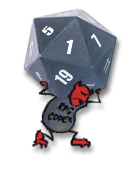As I said, there are no towns in Teudogar (neither in the Full nor Demo version), since Teutons did not live in towns back then. There are nothing but small villages and farmsteads. The main locations are Herwood, Cattanford, Heremod's Hall, Usipians' Refuge, Tiu's Grove, Roman Camp, Alwina's Cave, Bruglow, Burial Mound, Marada's Swamp, Ortruda's Forest, Ragangardis' Tower, Teudogar's Hoard, Adalmar's Estate, Roman Squad with Hostages, Brandolf's Farmstead, Osmund's Battlefield, plus several unnamed larger cave systems, forests and swamps.
As to the population (spread over these villages and farmsteads), I haven't bothered doing a headcount so far. There are about 200 animated portraits (i.e., faces of people you can talk to). And there are about 150 dialogues, most of them rather long, with a total of about 600 kB, or, printed on DIN A4 pages, with 2 columns, in 11pt Arial: about 250 pages. Including slaves, the resident population is probably around 300, plus an open number of robbers, plus probably several hundred cattle.
Now, in reality, Rome had a population of about 1 million during the reign of Augustus, around the birth of Christ, many of them living in 5-storey appartment buildings. In Germania, the largest Roman-Teutonic city would have been Oppidum Ubiorum (later to become the city of Cologne), with probably a few thousand inhabitants at that time (plus several thousand more if you included Roman troops stationed there in your count). Real Teutonic settlements/villages usually had only a few hundred inhabitants. This was due to agricultural necessities, and perhaps to the libertarian Teutonic lifestyle as well (anarchy is a pleasant and reasonable form of life when everybody sticks to his own farmstead, but it wouldn't work if you had to live together in densely populated, crowded cities).
(As you can see from these numbers, a village such as Herwood would have had over 100 inhabitants in real life - not just double-income-no-children couples, but lots of kids, plus grandparents, aunts and uncles and so on, on every farmstead. Teudogar simplifies and reduces this to the main protagonists for the sake of playability.)
Regarding the Full Version, I'd advise you (quebecguy) against ordering it, because I believe the aspects most important to you when playing this game may not be the ones that have been most important to me while writing it. Teudogar isn't focused on quantity. If anything, it is deep rather than wide. It tries to focus on quality, historical authenticity, and game depth. It's not so much about how many people you can talk to, but rather, about how intelligently these people will react to you, how your relationship with them will develop, plus how well they manage to give you a feeling for the way life was in barbarian Germania in 12 B.C. Apart from the fictional protagonists, almost everything you hear or see in Teudogar is actually true, i.e., historical fact (and hopefully presented in an interesting manner). It lets you swap your present urban, civilized, tax-paying and law-respecting life for the archaic, anarchic, wild, heroic, superstitious and barbarian life of our ancestors of many centuries ago - and it offers not just a fantasy, but gives you the actual truth. That is, in my point of view, what makes Teudogar unique and enjoyable.
For everyone not-so-much-culturally-inclined, or who simply has different interests, I'd recommend DARGHUL instead, the fantasy RPG I'm currently working on: That _does_ focus on quantity and offers a game world a dozen times as large as Teudogar's, with over 185 locations plus 360 dungeons/caves, and a population of several thousands (including Orcs, Goblins, and all the other regular fantasy fare)...










